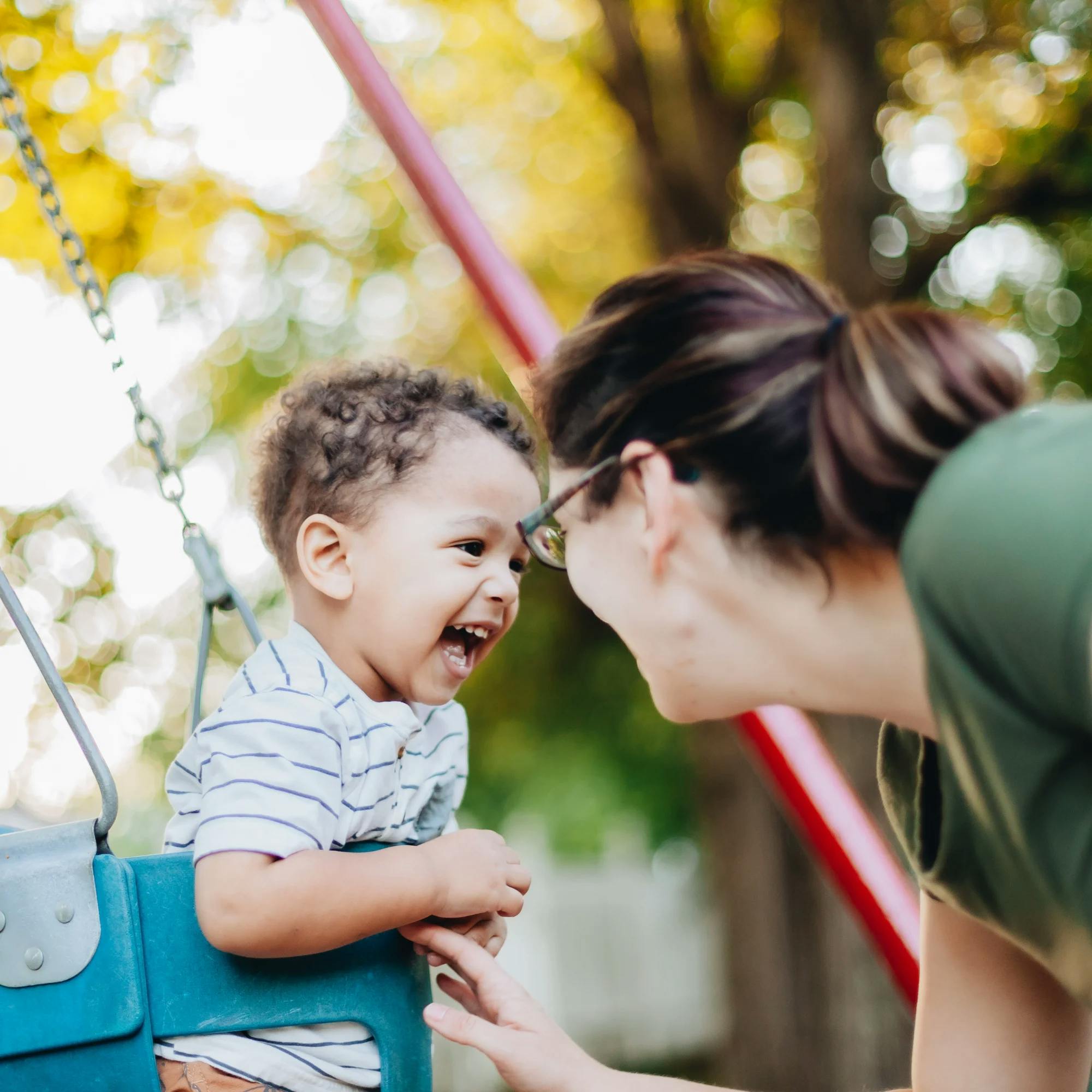When we think of language, most of us think about communicating through words—also known as “expressive language.” But there’s another part to language: understanding someone’s words and actions. This is called “receptive language,” and it comes before children learn to talk.
A baby’s first steps are considered a major milestone in their life. But a child doesn’t simply get up one morning and decide to walk after months of crawling. Instead, learning to walk is a process, involving scooting, cruising, and wobbling before taking steps on their own.
Language is similar. Although we think of a baby’s first word as the beginning of their language development, they’ve actually been observing and absorbing words and gestures for months before that. This is called receptive language.
“As children grow and develop their communication skills, they must first be able to understand language in order to use it themselves,” says Alexis Irazoque, MS, L/SLP, a licensed speech-language pathologist with Expressable.
But there’s a lot more to receptive language than simply comprehending the words we hear. This guide covers language milestones, signs to watch, simple at-home strategies, and when to check in with a speech-language pathologist.
How to use this guide
This guide will provide you with an easy-to-digest explanation of receptive language. You should be able to skim the definitions, find your child’s age group, and choose two or three strategies to try with them this week.
While you’re at it, keep a log of new ways your child is showing they understand language, like following directions, pointing, and making choices. And don’t worry if everything doesn’t happen at once: kids make progress at their own pace. It’s important to notice and celebrate the small wins along the way.
What is receptive language?
Receptive language refers to the understanding of words, gestures, and directions. According to Irazoque, receptive language involves:
Listening to and following directions
Understanding words, conversations, and stories
Processing and understanding written text
Understanding questions and giving appropriate responses
Understanding gestures, facial expressions, and body language
Knowing the meaning of words and understanding how they are put together in sentences (in other words, understanding grammar)
Receptive communication develops in children before their ability to talk in complex sentences. “Understanding always comes first—and honestly, it has to,” says Denise Moore Revel, PhD, CCC-SLP, a speech-language pathologist with decades of experience who trains educators and parents on the foundations of speech and language development. “A child has to understand the language before they can produce or use it. Babies soak up language for months, sometimes over a year, before they ever say their first word. They're listening, watching, and connecting sounds with meaning.”

Examples of receptive language
Some core receptive language skills, according to Irazoque and Revel, include:
Understanding vocabulary and grammar, including the meaning of words (e.g., prepositions like “on top” and “between,” object names, and action words) and how they are put together to form sentences
Following directions, including simple requests (“Give me the ball”) and multi-step tasks (“Stand up, go to the door, and put your shoes on”)
Understanding what someone means when they point to an object
Understanding conversations and stories
Understanding questions and giving appropriate responses
Identifying pictures, people, objects, and actions
A child can typically start following directions once they have a few dozen words. Start with something simple (“Get your shoes”), then two-step directives (“Get your shoes and bring them to the door”). Next, your child can understand conceptual directions (“Put your shoes under the seat’), and finally more complex directives (“After you take off your shoes, bring your lunchbox to the kitchen”).
But receptive language goes beyond words. It also involves nonverbal communication, including facial expressions, gestures, and body language, Revel says.
“After working with children for over 30 years, I often tell parents: it's what happens before the talking starts that’s important,” she explains. “When a child listens to you say, ‘Go get your shoes’ and actually goes to find them, or when they point to the dog you mention, that’s receptive language being demonstrated. It’s their brain saying, ‘I get it! I understand the words being used around me!,’ even if their mouth isn’t saying much yet.”
There are a number of factors that could impact the development of receptive language, including:
Neurological issues
Genetics
The child’s environment
Problems with auditory processing
Receptive vs. expressive language
In short, receptive language is understanding and learning what others communicate to you. Expressive language is sharing your own ideas with words, gestures, signs, and/or an AAC device. Growth often begins with receptive gains that unlock expressive language. In other words, a child may understand far more than they can say.

Developmental milestones (a child’s understanding by age)
A child picks up most of their speech and language skills in the first five years of their life, when their brain grows the fastest. Here’s a quick breakdown of their developmental milestones, according to the National Institute on Deafness and Other Communication Disorders:
12-24 months:
Responds to their name
Points to common items
Follows one-step directions with gestures
Uses new words on a regular basis
Puts two words together (“More cookie”)
Points to pictures, when named, in books
Enjoys simple stories, songs, and rhymes
Uses many different consonant sounds at the beginning of words
2-3 years:
Understands simple “Who?” “What?” “Where?” and “Why?” questions
Follows two-step directions in routines
Has a word for almost everything
Names objects to ask for them or to direct attention to them
Uses two- or three-word phrases to talk about and ask for things
Uses the /k/, /g/, /f,/ /t/, /d/, and /n/ speech sounds
Speaks in a way that is understood by family members and friends


3-4 years:
Understands basic concepts (in/on/under, big/small)
Answers simple questions about stories
Answers simple “Who?” “What?” “Where?” and “Why?” questions
Talks about activities at daycare, preschool, or friends’ homes
Uses sentences with four or more words
Speaks easily without having to repeat syllables or words
4-5+ years:
Follows multi-step directions
Understands time words (first/then); answers why/how questions
Communicates easily with other children and adults
Uses adult grammar
Pays attention to a short story and answers simple questions about it
Hears and understands most of what’s said at home and in school
Uses sentences that give many details
Tells stories that stay on topic
Names some letters and numbers
Says most sounds correctly except for a few (/l/, /s/, /r/, /v/, /z/, ch, sh, and th)
Uses rhyming words
Curious or concerned?
Our free screener is tailored by age and covers all areas of speech, language, and feeding. Find out if your child might need speech therapy.
 Screener for children
Screener for childrenSigns your child may need extra support
Children grow and develop at different paces, and their language skills are no exception. But this may leave you with questions about when your child may need support with their receptive language.
Milestones can give parents helpful clues. But Irazoque offers these additional signs of receptive language problems:
Limited consistent response to their name or to simple directions
Difficulty identifying familiar objects/people in books or real life
Frequent “guessing” or copying other children instead of understanding directions
Frustration that increases with tasks that involve a lot of language
Any loss of previously understood skills—be sure to talk with your pediatrician if this happens
Difficulty learning new vocabulary words or grasping new concepts
Challenges answering questions or staying on topic during conversations
Confusion during group activities or storytime because they miss key details
If your child has any of these challenges, the first thing to rule out is hearing loss. “You would be surprised how many times I have worked with a child who seemed to have language delays, only to discover they had fluid in their ears or hearing loss that no one had caught yet,” Revel says. “A child cannot understand language they cannot hear clearly.”


Home strategies to build receptive language (play-based, pressure-free)
There are several home strategies parents can use to help build their child’s receptive language skills. Here are some of the most common, from Irazoque:
Show & say
When children are learning language, it helps for them to see and hear what words mean at the same time. You can do this by combining modeling, showing, and labeling.
Modeling: Instead of asking your child, “What’s this?,” try modeling, or saying, the word: “It’s a banana! Yum, banana!”
Showing: Use gestures and facial expressions to add meaning, such as waving while saying “bye-bye,” or pointing to a ball and saying, “Ball rolls!”
Labeling: Label everyday items as you go about your routines (“This is your cup,” “The car is going fast!”).
“These moments give the child repeated, low-pressure exposure to words and their meanings,” Irazoque says.
One idea at a time
Children understand best when language is clear and simple. Parents can try giving one direction or idea at a time, like “Get your shoes,” before adding “and put them by the door.” As the child’s comprehension grows, you can build up to two-step directions. “This helps prevent frustration and gives the child time to process what they’ve heard before moving on to the next step,” Irazoque notes.
Testing vs. teaching
It’s common for parents to ask lots of questions, like, “What’s this?” or “Can you say ‘ball’?” But if your child isn’t ready to answer, it can start to feel like a test. Instead, focus on teaching.
Teaching means:
Modeling new words (for example, “bye-bye”)
Repeating them naturally throughout the day (saying “bye-bye” to the mail carrier or the daycare provider)
Expanding on what your child says (they say “bye-bye,” you say “Yes, bye-bye Grandma!”)
Using gestures or actions to show meaning (waving while saying “bye-bye”)
“Children learn through hearing and seeing language used in real situations, not through being quizzed,” Irazoque says. “The goal is to make language learning feel fun and low-pressure.”
Quick demo: How to read a book to your child like a speech therapist
Watch hereOffering choices
Offering simple choices helps your child understand language and express themselves. Instead of open-ended questions like “What do you want for a snack?,” you can show two options and name them: “Apple or banana?” Pairing words with visuals (e.g., holding up each option) makes it easier for the child to connect what they hear with what they see. “Choices build confidence and help children communicate what they want in a clear and supported way,” Irazoque explains.
Pause & wait
When a parent asks their child a question or gives a direction, they should pause and give the child time to respond. Waiting five to 10 seconds might feel long, but it’s important! Young children need extra time to process what they hear and decide how to respond. “This patient pause teaches children that communication is a back-and-forth exchange,” Irazoque says.
If the child doesn’t answer, model the gesture, sound, or word they could use. For example, if you’ve asked your child which book they want to read, you could say the name of the book or point to it.

Routines as lessons
Everyday routines are full of learning opportunities. Getting dressed, mealtime, and cleanup time all help build receptive language. For example, the parent can ask the child to point to items (“Where’s your sweatshirt?”) or follow simple directions (“Sit on the floor,” “Bring me your shoes”). As your child’s skills grow, you can try two-step directions like “Get your brush and bring it to me.”
“Using language during daily routines helps children connect words to real-life actions and experiences,” Irazoque notes.
Book time
Reading together is one of the best ways to grow language comprehension. Talk about the pictures, point to objects, and describe what’s happening in the story. Ask your child to point to things you name (“Show me the bear”) or identify actions (“Who is jumping?”).
As your child progresses, you can ask simple comprehension questions, such as “What happened in the story?” or “Where did the boy go?” According to Irazoque, reading and talking about books introduces new words, builds listening skills, and creates meaningful moments of connection.


How to support a child with language challenges
If your child has receptive language challenges, small adaptations or changes at home can make a big difference. “When we adapt the environment, we give the child's brain more room to focus on what really matters—connection and comprehension,” Revel says.
According to Irazoque, visual supports like pictures, gestures, or schedules help bridge the gap between what your child hears and what they understand. Other visual supports like “first/then” boards and augmentative and alternative communication (AAC) methods can also help reduce the language load.
Honor every form of communication, whether it’s a gesture, word, or look. This way your child feels heard and can confidently participate.
Building predictable routines, slowing your pace, and giving your child extra time to process all help them better understand language, Irazoque adds. Sensory-friendly tweaks, like cutting down on distractions, reducing noise, offering quiet corners, and keeping directions predictable may also be useful for your child, Revel says. And if your home is bilingual, keep using both languages, as this will help improve your child’s understanding of communication.
It’s also important to be inclusive when it comes to language. “Inclusion means honoring every form of communication, whether it’s a gesture, a word, or a look. This way your child feels heard and can confidently participate,” Irazoque says.


Tips for classroom support
The challenges your child faces at school aren’t the same as the ones they experience at home. Here are some tips to support them in daycare or the classroom.
First, parents should ask for accommodations at school. “Get to know their teacher and the school staff,” Irazoque says. “It might help for the teacher to provide one-on-one attention and simpler instructions, encourage the child to interact with their classmates, or ask the child to repeat back directions to make sure they fully understand.” Your child may also qualify for an Individualized Education Plan (IEP) to support them in school.
Revel shares a few other tips for supporting your child in the classroom:
Give one direction at a time: Instead of "Get your folder, put your homework in the bin, and sit on the carpet," try: "Get your folder." (Pause.) "Put your homework in the bin." (Pause.) "Now sit on the carpet."
Pair language with visuals or demonstrations: Show and tell. Provide visuals or demonstrations as much as possible.
Check for understanding: Instead of "Do you understand?"—which almost always gets a head nod even when they don't—ask, "Tell me what you're going to do next" or "Show me what comes first.” This allows you to truly determine if the child has understood the instruction or needs more support.
Keep routines consistent: This way children can predict what's next. Visual schedules can help with this.
Build in pauses: This gives a child time to process what’s being communicated.
Your speech therapist can help you with these discussions. They can also prepare a helpful document or plan to share with your child’s teachers.


Supplies master list
Supporting a child with receptive language difficulties often involves using tools that make language more concrete and easier to understand. But you don’t need to run out and buy a bunch of supplies. Many objects you already have at home can be helpful. Here are some examples that Irazoque has used:
Picture cards or core-word boards are helpful because they pair words with visuals. This makes it easier for a child to connect spoken language to objects, actions, or concepts.
Board books with clear, simple images allow children to hear and see language in context, which builds vocabulary and comprehension.
Low-tech AAC systems, like communication boards or simple devices with buttons, provide an alternative way for children to express themselves and can reinforce understanding of words and concepts.
Gestures, props, and everyday objects also support learning by giving children concrete examples of what words mean. For example, rolling a ball while saying “ball rolls!” helps them link language to action.
When to seek an evaluation (red flags)
If a child often seems confused, doesn’t respond when spoken to, or struggles to follow directions even in familiar routines—and hearing loss has been ruled out—Irazoque says that it may be time to consult a speech-language pathologist. “Early identification and support can make a big difference in helping children build the language foundation they need for learning and connection,” she says.
According to Children’s Minnesota, a speech-language evaluation is recommended when a child:
Doesn’t use single words by 15 months
Doesn’t use 50 words or two-word phrases (for example, “more cookie”) by 24 months
Doesn’t follow two-step directions (“Get your coat and put on your shoes”) by 2 years of age
Isn’t understood at least 90% of the time when speaking by 4 years old
Is easily frustrated because others can’t understand them
Has difficulty interacting with kids their own age
Has difficulty with memory or problem-solving skills
Repeats words or sounds (“I, I, I, I wa- want a cookie”), or words sound “stuck” or “pushed,” especially if this last six months or longer or if the child has a negative reaction to their speech
Has a rough, breathy, or strained voice
Sounds “nasally” or like too much air is leaking though the nose when talking
On top of that, any setbacks or regression in language understanding or social skills are also signs that your child may need to see a speech therapist. Your child might have these challenges at home, at school, or in other settings. “I tell parents this all the time: ‘When in doubt, check it out,’” says Revel. “It never hurts to get a child screened to determine if further testing is needed.”
And also, the earlier you have an evaluation, the better. “Getting answers early makes a world of difference. You never regret seeking help sooner rather than later,” Revel explains. “Early intervention can be life-changing for a child.”


Working with a speech-language pathologist (SLP)
If you’ve decided to look into speech therapy, what should you expect when you work with a speech therapist? The first step is to schedule a comprehensive evaluation. “The goal is to understand how the child currently processes and responds to language so we can create a plan that truly fits their needs,” Irazoque says.
During the evaluation, parents can expect a mix of play-based activities, observation, and standardized assessments, depending on the child’s age. The speech therapist might ask the child to follow simple directions, point to pictures, identify objects, or respond to familiar words or phrases. Tools like the Preschool Language Scale (PLS-5) or other assessments can measure how the child understands and uses language.
When it comes to speech therapy for children, “sessions are designed to feel engaging and natural,” Irazoque says. “We use toys, books, and games to keep therapy playful and motivating. Children learn best when they’re having fun, so we embed goals into meaningful interactions. That might mean following directions while building with PlayDoh, or labeling items during a story.
“Every session is about connection,” Irazoque explains. “We meet the child where they are, build trust, and help them make sense of the language in their world.”
Goal setting
Setting goals in speech therapy is all about building skills step-by-step. “After the evaluation, we identify what the child already understands and where they’re having difficulty,” Irazoque says. “From there, we create individualized goals that support real-life communication.”
For children with receptive language challenges, therapy goals usually start with understanding simple, one-step directions like “Give me the ball.” The child gradually moves toward more complex, multi-step tasks, such as “Pick up your trains and put them in the box.” Other goals may focus on building vocabulary, answering questions, or understanding new concepts and grammar.
“We always tie goals to daily routines,” Irazoque explains. “That might mean practicing during snack time, play, or getting dressed, which are times when language naturally happens. This helps children apply what they’re learning in therapy to everyday life.”
“Speech therapy has been such a great entity and extremely necessary for my son with autism and expressive/receptive language disorder,” says a parent who uses Expressable. “He has made remarkable progress—communicating his needs, improving eye contact, and gaining confidence.”
Caregiver coaching
Your speech therapist should partner with you, showing you how to help your child at home so they keep making progress. Speech therapists use “caregiver coaching” to teach parents how to support their child's language development. After all, your child will have speech therapy once or twice a week, but you’re with them every day! Making even small changes to your child’s everyday routines can help them reach their communication goals.
You can learn more about how Expressable speech therapy works in our treatment guide to language delays and disorders.
Frequently asked questions
What is an example of receptive language?
Receptive language refers to the ability to understand the language we hear, see, or read. It includes understanding words, sentences, questions, directions, and even nonverbal communication like gestures and facial expressions.
What is receptive vs. expressive language?
Language development refers to two things: A child’s ability to learn and understand what’s said to them, called receptive language, and a child’s ability to communicate verbally or nonverbally, called expressive language.
What is receptive language for a 2-year-old?
By the time a child is 2, they should know a few parts of the body (and point to them when asked), follow simple commands, and answer simple questions. Children of this age typically enjoy simple stories, songs, and rhymes.
Why is receptive language important?
“Understanding language is critical to a child’s development. If the goal is to help a child clearly express their wants, needs, and desires, they first have to understand how to join a conversation and understand what’s said,” says Irazoque. “Receptive language is the basis of all of these skills.”
Key takeaways
Receptive language includes understanding words, conversations, and stories, and listening to and following directions.
While receptive language is understanding what others communicate to you, expressive language is sharing your own ideas using words, gestures, signs, and/or an AAC device.
While children develop language at their own pace, if they aren’t keeping up with major language milestones, it may be time to talk to a speech-language pathologist.
It’s important to make changes at home and school to support a child with receptive language differences.
How Expressable Can Help
Concerned your child isn't reaching age-expected milestones? Looking for communication support from a professional? Expressable is a national online speech therapy practice serving children and adults. We treat all major areas of communication and feeding, offer flexible hours including evenings and weekends, and accept most major health insurance plans. We’re proud to have earned more than 3,000 5-star reviews from our clients (4.9/5 average).
Our therapy model is centered on parent and caregiver involvement. Research proves that empowering caregivers to participate in their loved one’s therapy leads to better outcomes. That’s why we combine live, 1-on-1 speech therapy with personalized education and home practice activities for faster progress.
Communication is more than words. It’s how we share how we feel and show who we are. We’re here to help you or your child do just that.









